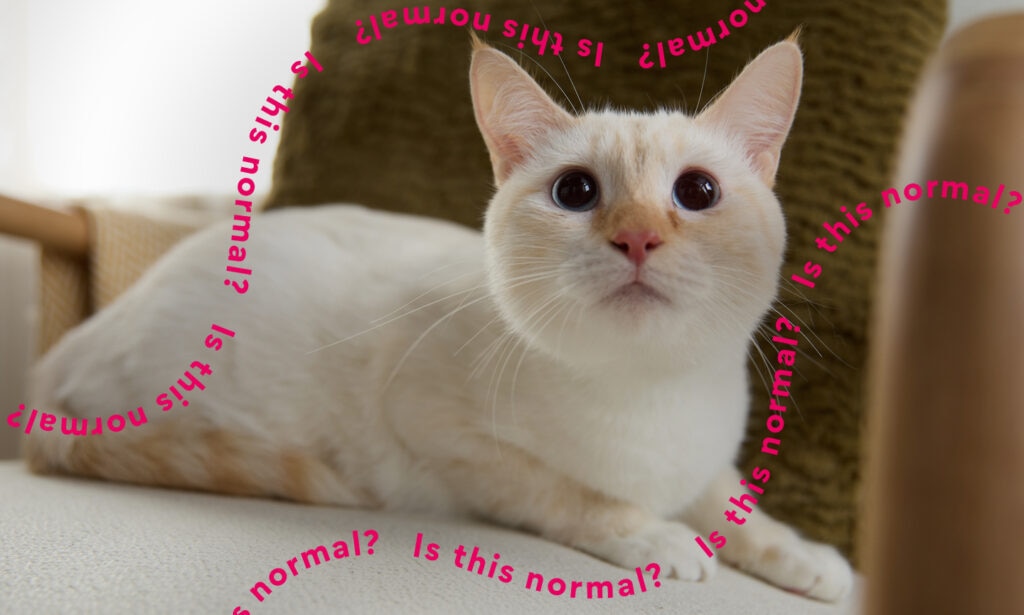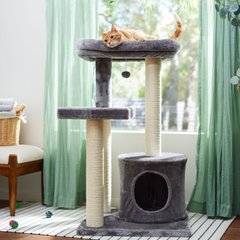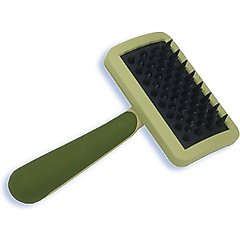Why Does My Cat Hate Belly Rubs? Is This Normal?

Photo by Chewy
Q: My cat nudges me to give her scritches but bites my hand whenever I pet her belly specifically. Why does my cat hate belly rubs? Is this normal?
A: Yes! It’s totally normal that some cats do not like belly rubs. As much as we want to give our feline friends’ fluffy tummies endless belly rubs, they may dislike them for several reasons. For instance, their bellies may be a vulnerable and sensitive area, or maybe they weren’t pet in that particular spot as kittens.
We spoke to experts to learn more about this completely instinctual behavior.
If you have any questions about your cat’s behavior, speak with your vet.
Key Takeaways
- It’s normal for cats not to like belly rubs. (Every cat is different!)
- It’s possible to teach a cat to tolerate—and maybe even like—belly rubs.
- There are certain spots where cats might prefer to be pet, like the sides of the face and under the chin, rather than their belly.
Why Do Cats Hate Belly Rubs?
You go to give your kitty a loving, good-intentioned belly rub and the next thing you know, you’re met with a swat or bite. What happened? After all, you were just petting the top of their head!
“It’s normal for some cats to not like belly rubs, but it’s by no means universal,” says Stephen Quandt, certified feline training and behavior specialist and founder of Stephen Quandt Feline Behavior Associates, LLC in New York City.
Here are the most common reasons cats hate belly rubs.
Their Belly Is a Vulnerable Area
“From an evolutionary point of view, the belly is a very vulnerable part of a cat’s body, and defending it is a survival tactic,” Quandt says. Because of this, some cats might naturally find belly rubs to be unpleasant or stressful.
They Weren’t Pet on Their Belly as Kittens
Socialization is crucial for cats, because it introduces them to different stimuli, like people, pets, places, and more. This process helps them grow up to be more confident in various situations and have more positive experiences. Thus, if a kitten wasn’t exposed to being pet on the belly, it could lead to a lifelong dislike of it, Quandt says.
They’re Misunderstood
Like people, cats have their personal boundaries. Depending on the feline, they might trust you enough to show you their belly, but this doesn’t necessarily mean they want a belly rub.
“We see a fluffy tummy and think ‘Pet me!’ but cats often extend as a relaxed gesture, not consent,” says Sabrina Kong, DVM, certified canine rehabilitation practitioner at Jules Veterinary Center in Tracy, California, and veterinary consultant at WeLoveDoodles.com.
Their Stomach Is Extremely Sensitive
In some cases, a cat’s reluctance to have their belly rubbed might be due to sensory overload. A cat’s belly fur contains hypersensitive nerve endings, and what feels like gentle petting to us can overwhelm them, Dr. Kong says.
They May Associate Belly Rubs With Unpleasant Experiences
Shy or scared kittens can be especially sensitive to what they feel are stressful events. As a result, some cats can associate belly touches with unpleasant experiences, like vet exams or grooming, Dr. Kong says. This negative association can cause them to dislike belly rubs outside of these experiences.
Can I Teach My Cat To Like Belly Rubs?
If you’re considering training your cat to like belly rubs, this may be possible with a respectful and gradual approach. However, keep in mind that most cats who really dislike belly rubbing are likely never going to like it or may need a lot of time to warm up to it, Quandt says.
Our experts share these tips on how to teach your cat to (maybe) like belly rubs:
1. Start Young If Possible
The social development window for a kitten is between 3–7 weeks of age.
During this time, gently stroking the belly can help them grow into a cat who enjoys that kind of touch, says Molly DeVoss, certified feline training and behavior specialist and founder of Cat Behavior Solutions in Dallas.
This is similar to when mother cats groom their kittens’ bellies and becomes a familiar sensation early in life, she adds.
2. Incorporate Counter-Conditioning
“Training an adult cat who already dislikes belly touch is more challenging but not impossible,” DeVoss says.
She recommends pairing short, light touches with a favorite cat treat to help your kitty become more tolerant. Some meow-worthy options to try include Purina Fancy Feast Hand-Flaked Tuna Treats and Purina Pro Plan Veterinary Diets Crunchy Bites.
Recommended Products
3. Use a Gradual Approach
Go slowly and work in short, frequent sessions to respect your cat’s wishes and avoid overwhelming them.
Pair treats with brief and gentle petting, using the briefest stroke of a single finger, Quandt says.
You can also use training tools, like the Travel Cat The Good Kitty Clicker Training Set, to help acclimate your kitty to belly rubs.
Recommended Product
4. Watch Your Cat’s Reaction
Reading your cat’s body language is a must. Success looks like your cat staying relaxed—not necessarily purring or soliciting more, Dr. Kong says.
Even if your cat grows to accept and like belly rubs, it’s possible they’ll only tolerate brief, occasional belly touches. If you’re training your cat, and they begin ignoring the treat or show signs of discomfort like flattening ears, swishing tail, or sudden stillness, stop immediately, DeVoss says.
With enough time and training, some cats might grow to accept and like belly rubs. Regardless of the outcome, it’s always best to honor your cat’s boundaries and avoid forcing contact to maintain trust and prevent defensive biting.
Do Cats Like Belly Rubs?
“Most cats prefer you avoid touching their tummy,” DeVoss says.
Whether a cat likes or hates belly rubs depends on the individual cat. Some cats, such as couch potato breeds, may be more tolerant, but it’s really about the cat’s preferences, Quandt says.
Quandt notes that some reasons cats might like belly rubs include:
- They enjoy the sensation.
- They have a connection to the person giving them belly rubs.
- It feels good!
If your kitty companion prefers not to have their belly rubbed, other ways you can engage with and strengthen your bond with them include:
- Providing a safe space to rest, like a Lesure Calming Jacquard Shaggy Orthopedic Anti-Slip Donut Bed
Recommended Product
- Creating a feline-friendly environment with amenities, like cat trees and scratching posts
Recommended Products
- Encouraging them to exercise with games and activities, such as playing with cat toys, like the Frisco Bird with Feathers Teaser Wand and the Frisco Colorful Springs Cat Toy
Recommended Products
Where Do Cats Like To Be Pet?
If your little fluffball doesn’t like belly rubs, that’s purr-fectly OK! There are plenty of other wonderful places to pet your cat, DeVoss says.
According to our experts, some spots cats enjoy being pet include:
- Sides of the face
- Under the chin
- Forehead
- Top of the head
Cats may prefer affection in these areas because they contain social pheromone glands, and it’s in the cat’s interest to distribute these scents, Quandt says.
A few areas where cats might dislike being pet include:
- The base of their tail
- Down the spine (possibly)
- The paw
- The tail
“To maintain a close, trusting relationship with your cat, always watch their body language and respect their boundaries,” DeVoss says. “The key to connection is consent.”
If your best furry friend isn’t quite comfortable being pet yet, you can try introducing them to being brushed or pet with grooming tools, like the Pet Republique Long Sleeve Silicone Bathing Gloves, Safari Massage Cat Brush, or the FURminator Long Hair Cat Deshedding Tool.
Recommended Products
When in doubt, you can also see if they’re up for some cuddles!
FAQs About Cat Belly Rubs
Why don’t cats like belly rubs?
Cats may not like belly rubs for several reasons, such as the belly being a sensitive and vulnerable area, lack of exposure to belly rubs as a kitten, or trust misinterpretation.
Are some breeds more tolerant of belly rubs?
Maybe. Some cat breeds, like Persians, Ragdolls, and Russian Blues, might be more tolerant of belly rubs. However, it ultimately depends on each cat’s preference.
Where should I pet my cat instead of the belly?
Instead of petting your cat on the belly, try gently petting them on the sides of their face, under their chin, or on the top of their head.














